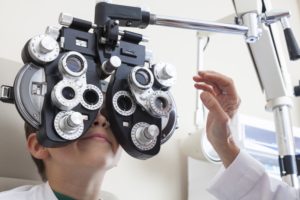February 1, 2022
By Divya Jagadeesh, PhD, Postdoctoral Research Fellow at the Brien Holden Vision Institute
 Retinal defocus is considered a causative factor for the pathogenesis of myopia. Progressive addition lenses (PALs) produce clear vision over a range of distances from near to far and, therefore, could reduce the defocus and slow the progression of myopia. This concept was studied in the Correction of Myopia Evaluation Trial (COMET), a National Eye Institute/National Institutes of Health–supported multicenter clinical trial that evaluated the efficacy of PALs in comparison to conventional correction with single vision lenses (SVLs) to slow the rate of progression of juvenile-onset myopia.
Retinal defocus is considered a causative factor for the pathogenesis of myopia. Progressive addition lenses (PALs) produce clear vision over a range of distances from near to far and, therefore, could reduce the defocus and slow the progression of myopia. This concept was studied in the Correction of Myopia Evaluation Trial (COMET), a National Eye Institute/National Institutes of Health–supported multicenter clinical trial that evaluated the efficacy of PALs in comparison to conventional correction with single vision lenses (SVLs) to slow the rate of progression of juvenile-onset myopia.
In this study, 469 myopic children aged 6 to 11 years with no underlying ocular pathologies were randomly fit with either SVLs or PALs (Varilux Comfort lenses with a +2.00D addition: Essilor of America). A +2.00D addition was chosen. Study optometrists were masked about the intervention strategy used or individual participants. Cycloplegic autorefraction was used to analyze the rate of progression of myopia in these children and was defined as the change in spherical equivalent refractive error (SER) relative to baseline (a continuous measure). The secondary outcome for COMET was change in axial length (AL) during follow-up relative to baseline measured by A-scan ultrasonography.
Primary outcome:
- The adjusted three-year treatment effect between PALs and SVLs was statistically significant; SER = 0.20 ± 0.08D, p =0.004. This was after adjusting for age, gender, ethnicity, baseline SER, accommodative response, and near point phoria.
- The overall astigmatism increased a little more than 0.25D over three years between the two treatment groups; however, this was not considered a significant difference.
- The treatment effect was found to be more effective in children 1) with lower versus higher accommodative response and 2) with low myopia in comparison to higher myopia.
- The treatment effect was found to be larger in children who read closer than the reported median of 12 inches.
Secondary outcome:
- The adjusted three-year mean AL between PALs and SVLs was statistically significant, AL = 0.11 ± 0.03 mm, p =0.0002.
- In AL-related analysis, the treatment effect was found to be more effective in children with lower versus higher accommodative response.
Adherence to glass wear: Overall, 93% of the PAL group and 96% of the SVL group reported wearing glasses all the time.
Synopsis
The treatment effect calculated with an adjusted mean difference in three-year SER between the PAL and the SVL group of 0.20D, although statistically significant, was not considered to be clinically relevant. The authors further discuss that retinal defocus resulting from insufficient accommodation when children engage in close work may be a stimulus for axial length elongation.
Abstract
A Randomized Clinical Trial of Progressive Addition Lenses Versus Single Vision Lenses on the Progression of Myopia in Children
Jane Gwiazda, Leslie Hyman, Mohamed Hussein, Donald Everett, Thomas T Norton, Daniel Kurtz, M. Cristina Leske, Ruth Manny, Wendy Marsh-Tootle, Mitch Scheiman, and the COMET Group
Purpose: The purpose of the Correction of Myopia Evaluation Trial (COMET) was to evaluate the effect of progressive addition lenses (PALs) compared with single vision lenses (SVLs) on the progression of juvenile-onset myopia.
Methods: COMET enrolled 469 children (ages 6–11 years) with myopia between -1.25 and -4.50D spherical equivalent. The children were recruited at four colleges of optometry in the United States and were ethnically diverse. They were randomly assigned to receive either PALs with a +2.00D addition (n = 235) or SVLs (n = 234), the conventional spectacle treatment for myopia, and were followed for 3 years. The primary outcome measure was progression of myopia, as determined by autorefraction after cycloplegia with 2 drops of 1% tropicamide at each annual visit. The secondary outcome measure was change in axial length of the eyes, as assessed by A-scan ultrasonography. Child-based analyses (i.e., the mean of the two eyes) were used. Results were adjusted for important covariates, by using multiple linear regression.
Results: Of the 469 children (mean age at baseline, 9.3 ± 1.3 years), 462 (98.5%) completed the 3-year visit. Mean (± SE) 3-year increases in myopia (spherical equivalent) were -1.28 ± 0.06D in the PAL group and -1.48 ± 0.06D in the SVL group. The 3-year difference in progression of 0.20 ± 0.08D between the two groups was statistically significant (P =0.004). The treatment effect was observed primarily in the first year. The number of prescription changes differed significantly by treatment group only in the first year. At 6 months, 17% of the PAL group versus 30% of the SVL group needed a prescription change (P = 0.0007), and, at 1 year, 43% of the PAL group versus 59% of the SVL group required a prescription change (P= 0.002). Interaction analyses identified a significantly larger treatment effect of PALs in children with lower versus higher baseline accommodative response at near (P =0.03) and with lower versus higher baseline myopia (P= 0.04). Mean (± SE) increases in the axial length of eyes of children in the PAL and SVL groups, respectively, were: 0.64 ± 0.02 mm and 0.75 ±0.02 mm, with a statistically significant 3-year mean difference of 0.11± 0.03 mm (P = 0.0002). Mean changes in axial length correlated with those in refractive error (r= 0.86 for PAL and 0.89 for SVL).
Conclusion: Use of PALs compared with SVLs slowed the progression of myopia in COMET children by a small, statistically significant amount only during the first year. The size of the treatment effect remained similar and significant for the next 2 years. The results provide some support for the COMET rationale — that is, a role for defocus in progression of myopia. The small magnitude of the effect does not warrant a change in clinical practice.
Gwiazda, J., Hyman, L., Hussein, M., Everett, D., Norton, T. T., Kurtz, D., … & COMET Group. (2003). A randomized clinical trial of progressive addition lenses versus single vision lenses on the progression of myopia in children. Investigative ophthalmology & visual science, 44(4), 1492-1500.
DOI: 10.1167/iovs.02-0816
 |
Divya Jagadeesh, PhD, is a postdoctoral research fellow at the Brien Holden Vision Institute. |













